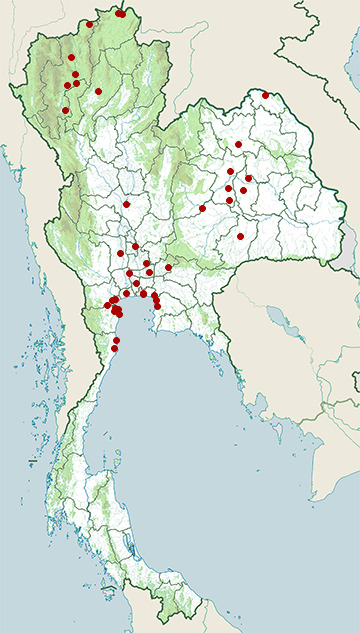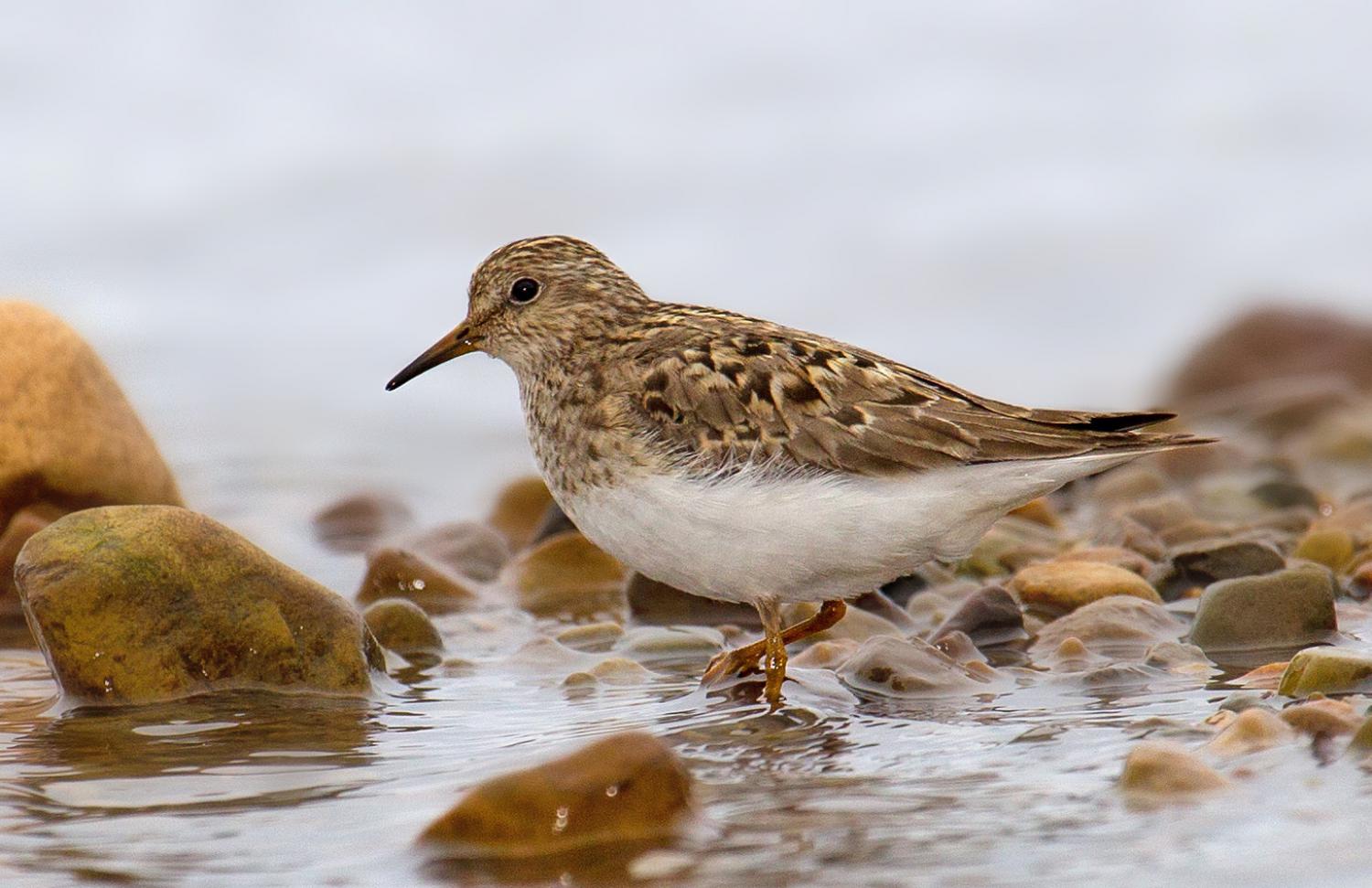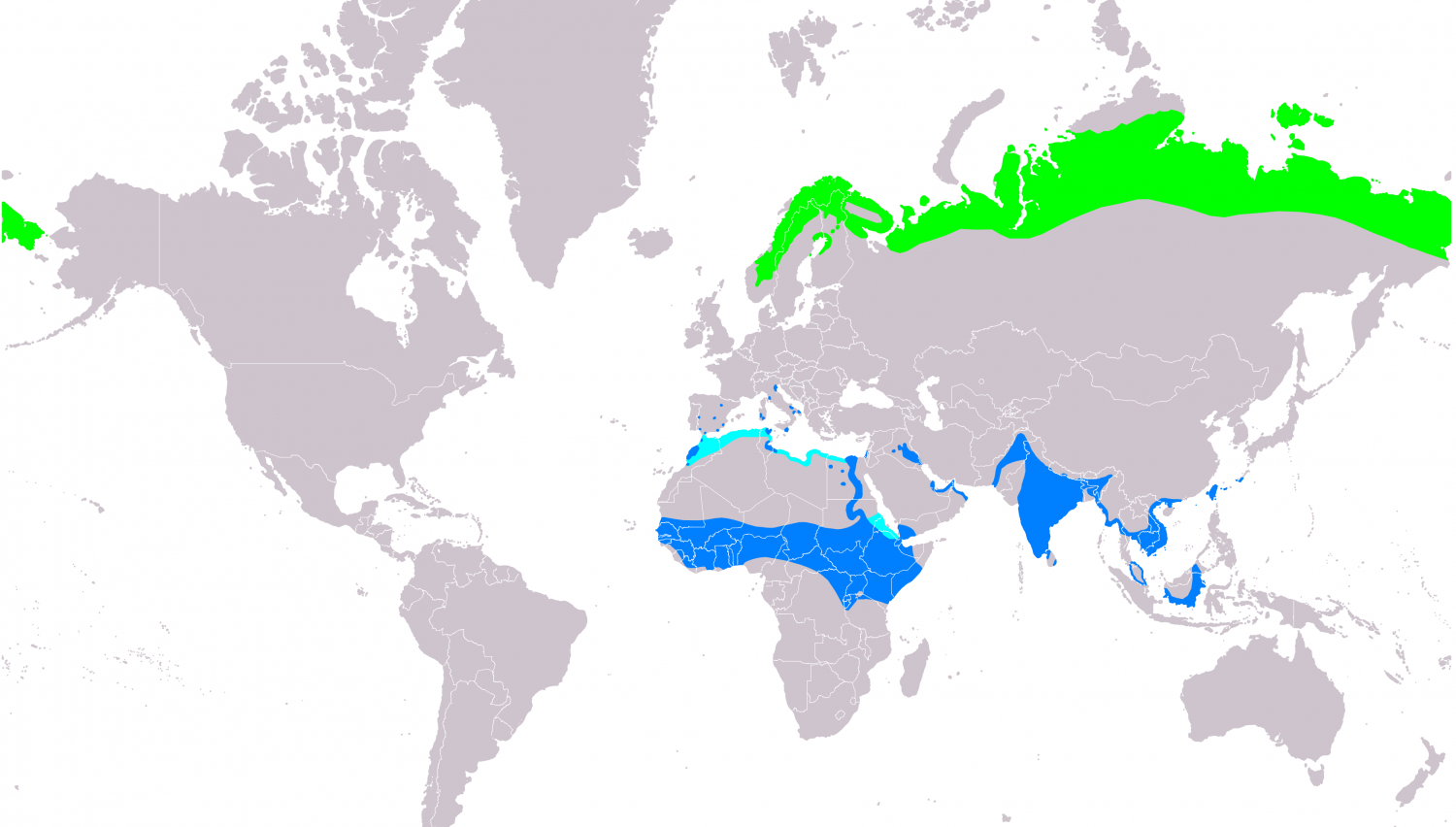Species of Thailand
Temminck's stint
Calidris temminckii
Johann Philipp Achilles Leisler, 1812
In Thai: นกสติ๊นท์อกเทา
Temminck's stint (Calidris temminckii) is a small wader. This bird's common name and Latin binomial commemorate the Dutch naturalist Coenraad Jacob Temminck. The genus name is from Ancient Greek kalidris or skalidris, a term used by Aristotle for some grey-coloured waterside birds.
Temminck's stint is one of the species to which the Agreement on the Conservation of African-Eurasian Migratory Waterbirds (AEWA) applies.
Description
These birds are very small waders, at 13.5 – 15 cm length. They are similar in size to the little stint (Calidris minuta) but shorter legged and longer winged. The legs are yellow and the outer tail feathers white, in contrast to little stint's dark legs and grey outer tail feathers.
This is a rather drab wader, with mainly plain brown upperparts and head, and underparts white apart from a darker breast. The breeding adult has some brighter rufous mantle feathers to relieve the generally undistinguished appearance. In winter plumage, the general appearance recalls a tiny version of common sandpiper.
The call is a loud trill.
Breeding
This stint's breeding habitat is bogs and marshes in the taiga of Arctic northern Europe and Asia. It will breed in southern Scandinavia and occasionally Scotland. It has a distinctive hovering display flight. It nests in a scrape on the ground, laying 3–4 eggs. Temminck's stint is strongly migratory, wintering at freshwater sites in tropical Africa, the Indian Subcontinent and parts of Southeast Asia.
Temminck's stints have an intriguing breeding and parental care system in which males and female parents incubate separate clutches, typically in different locations. Males establish small territories and mate with a female who lays a first clutch of eggs. She then moves to a second territory and mate, and lays a second clutch that she incubates herself. Concurrently, her first male may mate with an incoming second female, who lays her second clutch on his territory. The male thereafter incubates his first mate's first clutch alone.
An apparent hybrid between this species and the little stint has been reported from the Netherlands.
Feeding
These birds forage in soft mud with some vegetation, mainly picking up food by sight. They have a distinctive mouse-like feeding behaviour, creeping steadily along the edges of pools. They mostly eat insects and other small invertebrates. They not as gregarious as other Calidris waders, and rarely form large flocks.
This article uses material from Wikipedia released under the Creative Commons Attribution-Share-Alike Licence 3.0. Eventual photos shown in this page may or may not be from Wikipedia, please see the license details for photos in photo by-lines.
Category / Seasonal Status
Wiki listed status (concerning Thai population): Winter visitor
BCST Category: Recorded in an apparently wild state within the last 50 years
BCST Seasonal status: Non-breeding visitor
Scientific classification
- Kingdom
- Animalia
- Phylum
- Chordata
- Class
- Aves
- Order
- Charadriiformes
- Family
- Scolopacidae
- Genus
- Calidris
- Species
- Calidris temminckii
Common names
- English: Temminck's Stint
- French: Bécasseau de Temminck
- Thai: นกสติ๊นท์อกเทา
Conservation status

Least Concern (IUCN3.1)
Photos
Please help us review the bird photos if wrong ones are used. We can be reached via our contact us page.
Range Map

- Amphawa District, Samut Songkhram
- Ban Laem District, Phetchaburi
- Ban Lueam District, Nakhon Ratchasima
- Ban Phai District, Khon Kaen
- Bang Pakong District, Chachoengsao
- Bang Phra Non-Hunting Area
- Bang Pu Recreation Centre
- Bangkok Province
- Borabue District, Maha Sarakham
- Bueng Boraped Non-Hunting Area
- Chaiyo District, Ang Thong
- Chiang Saen District, Chiang Rai
- Doi Lo District, Chiang Mai
- Doi Tao District, Chiang Mai
- Huai Chorakhe Mak Reservoir Non-Hunting Area
- Kantharawichai District, Maha Sarakham
- Khao Sam Roi Yot National Park
- Khao Yoi District, Phetchaburi
- Kumphawapi District, Udon Thani
- Kut Thing Non-Hunting Area
- Laem Pak Bia
- Mae Ai District, Chiang Mai
- Mae Taeng District, Chiang Mai
- Mueang Chiang Mai District, Chiang Mai
- Mueang Chonburi District, Chonburi
- Mueang Khon Kaen District, Khon Kaen
- Mueang Lampang District, Lampang
- Mueang Lamphun District, Lamphun
- Mueang Phetchaburi District, Phetchaburi
- Mueang Samut Sakhon District, Samut Sakhon
- Mueang Samut Songkhram District, Samut Songkhram
- Mueang Suphanburi District, Suphan Buri
- Nong Bong Khai Non-Hunting Area
- Nong Song Hong District, Khon Kaen
- Pak Phli District, Nakhon Nayok
- Pak Thale
- Pran Buri Forest Park
- Sai Noi District, Nonthaburi
- Samut Prakan Province
- Thanyaburi District, Pathum Thani
- Wang Noi District, Phra Nakhon Si Ayutthaya


